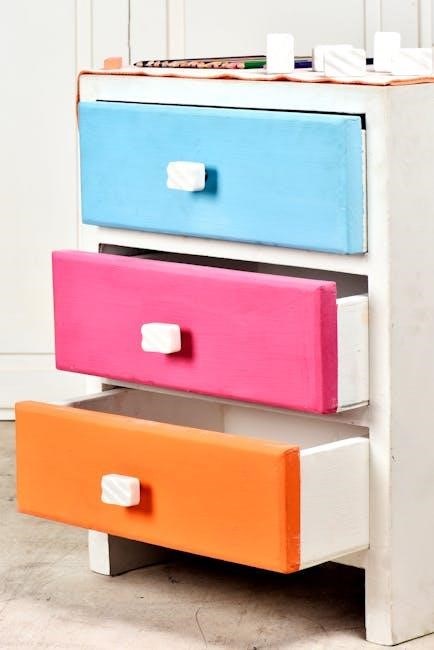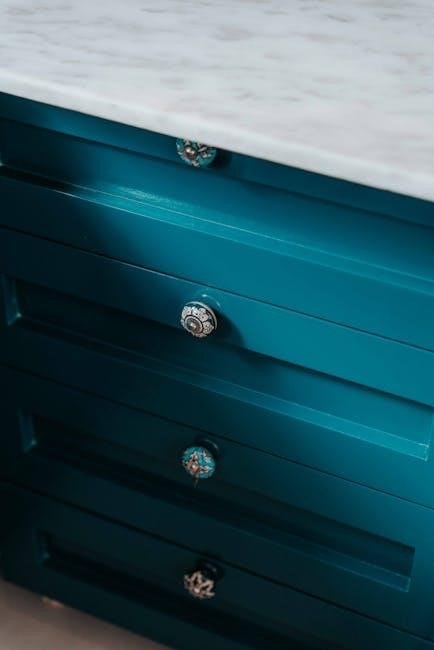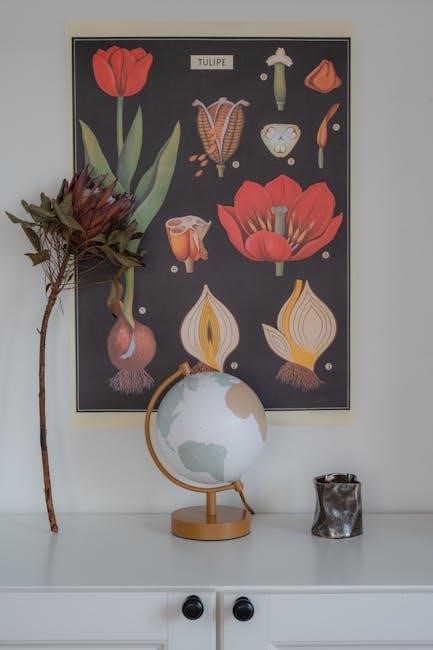Cabinet knob placement is crucial for both functionality and aesthetics, impacting ease of use and visual appeal. Proper positioning enhances design harmony and user experience, often overlooked yet transformative.
Why Proper Placement Matters for Functionality and Aesthetics
Proper cabinet knob placement is essential for balancing functionality and aesthetics. Incorrect positioning can hinder ease of access, while correct placement enhances usability and visual harmony. Knobs that are too low or high may be inconvenient, whereas centered or strategically placed knobs improve ergonomics. Aesthetically, consistent placement ensures a cohesive design, aligning with the cabinet style and hardware choice. Poor placement can disrupt the overall look, making it crucial to prioritize both practicality and visual appeal for a polished result.
Traditional Placement for Cabinet Knobs
Traditional cabinet knob placement centers the knob in the corner of the face frame, aligning it with both the stile and rail for a balanced look. The 2-1/2″ rule places knobs 2.5 inches from the bottom of upper doors or top of lower doors, ensuring ergonomic access and visual harmony across various cabinet styles.
Centering Knobs on Stiles and Rails
Centering knobs on stiles and rails ensures symmetry and balance. For five-piece paneled cabinets, the knob is placed in the center of the face frame, aligning with both the vertical stile and horizontal rail. This classic positioning creates a harmonious look, making the knob equally visible from all angles. The centering method works for various cabinet styles, including Shaker and paneled designs, ensuring a cohesive and visually appealing result that complements the cabinetry’s overall aesthetic.
The 2-1/2″ Rule: Distance from Bottom or Top
The 2-1/2″ rule is a standard guideline for knob placement, ensuring consistency and functionality. For upper cabinets, knobs are placed 2-1/2 inches from the bottom of the door, while for lower cabinets, they are positioned 2-1/2 inches from the top. This measurement aligns the knob stile height with the inside edge of the rail, creating a balanced look. The rule applies universally to most cabinet styles, ensuring ergonomic access and visual harmony, while maintaining design consistency across the space.

Knob Placement on Cabinet Drawers
Knob placement on cabinet drawers offers two options: centered for symmetry or higher for easy access. Centered knobs suit paneled or slab drawers, while higher placement enhances accessibility.
Centered Knob Placement for Symmetry
Centered knob placement ensures symmetry, creating a balanced look on cabinet drawers. This method works well for both paneled and slab drawers, maintaining visual harmony. Proper alignment tools are essential for precise installation, ensuring knobs are evenly spaced and level. Centered placement avoids visual clutter, making it ideal for minimalist designs. It also complements uniform hardware finishes, contributing to a cohesive aesthetic. This approach is timeless and suits various cabinet styles, enhancing overall design consistency.
Higher Knob Placement for Easy Access
Higher knob placement enhances accessibility, particularly for frequently used drawers. Positioning knobs about 2 inches from the top edge ensures easy gripping and reduces strain. This method is ideal for taller users or for heavy drawers that require a firm grasp. Higher placement also complements modern designs, creating a sleek appearance. It ensures functionality without compromising aesthetics, making it a practical choice for contemporary kitchens and bathrooms. This approach prioritizes comfort and convenience while maintaining visual appeal.

Cabinet Hardware Options and Their Impact on Placement
Cabinet knobs and pulls come in various styles, from classic knobs to modern pulls. Choosing the right hardware significantly influences placement, ensuring functionality and aesthetic harmony. Mixing styles and finishes can add visual interest while maintaining a cohesive design. Proper alignment and spacing are key to achieving a polished look that enhances both usability and appeal. Hardware selection must align with cabinet style and user preference for optimal results.
Understanding Knob and Pull Styles
Cabinet hardware includes knobs and pulls in various styles, each offering unique aesthetic and functional benefits. Knobs are circular or oval and ideal for traditional designs, while pulls provide a modern look with bar, recessed, or tab options. Cup pulls and finger pulls add rustic or minimalist touches. Styles vary in size, material, and finish, allowing customization to suit cabinet design. Choosing the right style enhances functionality and complements the overall cabinetry aesthetic, ensuring a cohesive and visually appealing result.
Choosing the Right Hardware for Your Cabinet Style
Selecting hardware that complements your cabinet style ensures a harmonious design. For Shaker cabinets, simple knobs or cup pulls align with their classic look; Slab cabinets benefit from minimalist pulls or recessed handles for a sleek appearance. Inset cabinets may use button knobs or small pulls for a flush finish. Consider the cabinet’s material, finish, and overall design when choosing hardware to achieve a cohesive and polished look that enhances functionality and aesthetics without compromising style.
Placement Guidelines for Different Cabinet Styles
Shaker, slab, and inset cabinets each require tailored hardware placement. Shaker cabinets often feature knobs centered on stiles, while slab cabinets prefer minimalist pulls for a sleek look.
Shaker Cabinets: Classic Knob Positioning
For Shaker cabinets, knobs are traditionally placed at the center of the stile, aligning with the inside edge of the rail. This classic positioning ensures symmetry and balance, complementing the clean lines of Shaker-style cabinets. The knob is typically centered vertically on the stile and horizontally between the rails, creating a timeless look. This method emphasizes functionality while maintaining the aesthetic integrity of the Shaker design, making it a popular choice for both modern and traditional kitchens.
Slab Cabinets: Minimalist Knob Placement
Slab cabinets, with their flat, unadorned surfaces, benefit from a minimalist approach to knob placement. Knobs are typically centered on the door or drawer front, emphasizing simplicity and clean lines. This placement avoids visual clutter, aligning with the slab style’s modern aesthetic. The lack of frame details allows for versatility, ensuring knobs complement the sleek design without overpowering it. This understated positioning enhances functionality while maintaining the cabinet’s contemporary appeal. Centered knobs create a harmonious look, ideal for minimalist interiors.
Inset Cabinets: Knob Placement for Flush Doors
Inset cabinets, with doors flush to the frame, require knob placement that aligns with their seamless design. Knobs are typically centered on the stile, maintaining symmetry and balance. The 2-1/2″ rule applies, placing knobs 2-1/2″ from the bottom or top of doors for consistency. This placement ensures functionality while preserving the clean aesthetic of inset cabinets. The flush nature of the doors makes precise alignment crucial to avoid visual disruption, enhancing both form and function in the kitchen or bathroom space.
Pantry Cabinets: Unique Placement Considerations
Pantry cabinets, often taller, require ergonomic knob placement around elbow height (36-40″ from the floor) for easy access, ensuring convenience without compromising design or functionality.
Elbow Height Placement for Pantry Cabinets
Placing knobs at elbow height, typically between 36-40 inches from the floor, optimizes accessibility for pantry cabinets. This ergonomic positioning ensures comfort during frequent use, reducing strain while maintaining a cohesive design. It aligns with the natural reach of most individuals, making it practical for everyday interaction. This placement also complements the taller stature of pantry cabinets, seamlessly integrating functionality with aesthetic considerations for a polished look.

Functionality and Ergonomics in Knob Placement
Proper knob placement ensures ease of use, accessibility, and comfort. It reduces strain and enhances intuitive operation, balancing practicality with design to create a seamless user experience.
Optimizing Knob Position for Ease of Use
Optimizing knob position involves strategic placement to ensure comfort and accessibility. For upper cabinets, positioning knobs about 2-1/2 inches from the bottom allows easy reach. On drawers, placing knobs near the top enhances accessibility, reducing strain. This ergonomic approach ensures that users can effortlessly open cabinets without discomfort, making the design both functional and user-friendly. Proper alignment also prevents wear and tear, maintaining smooth operation over time.
Mixing Hardware Types for Visual Interest
Mixing hardware types like knobs, pulls, and latches creates visual interest and depth. Combining styles while keeping a uniform finish ensures a cohesive, polished design.
Combining Knobs, Pulls, and Latches
Combining knobs, pulls, and latches adds functionality and visual interest to cabinetry; Knobs provide easy grip for smaller doors, while pulls offer a modern, sleek look for drawers. Latches, often decorative, can add a vintage touch. Mixing these elements creates a layered design, enhancing both style and usability. Balance is key to avoid clutter, ensuring a cohesive look. Proper placement and consistent finishes maintain harmony, making mixed hardware a versatile choice for various cabinet styles and design preferences.
Consistency in Hardware Finish and Style
Consistency in hardware finish and style ensures a polished, cohesive design. Uniform finishes like polished nickel or matte black unify the look, enhancing overall aesthetic harmony and functionality.
Uniform Finish for Cohesive Design
A uniform finish across all cabinet hardware ensures a polished and cohesive design. Consistency in finishes like polished nickel, matte black, or antique brass avoids visual clutter and creates harmony. This approach ties together diverse design elements, making the space feel intentional and curated. Mixing finishes can disrupt the aesthetic, so selecting a single finish maintains balance and sophistication. Uniformity in hardware finish is essential for achieving a professional, high-end look in any kitchen or cabinetry design.
Common Mistakes to Avoid in Knob Placement
Common errors include inconsistent alignment, incorrect measurements, and neglecting cabinet style. Improper placement can compromise functionality and aesthetics, so careful planning is essential for a polished look.
Errors That Compromise Functionality and Aesthetics
Common mistakes include inconsistent knob alignment, incorrect spacing from edges, and ignoring cabinet style. Misaligned knobs disrupt visual harmony, while improper distances compromise ease of use. Overlooking hardware consistency can clash with the overall design. Additionally, placing knobs too close to edges may hinder functionality, and failing to consider cabinet style, such as Shaker vs. slab, can result in a mismatched look. These errors can detract from both usability and aesthetic appeal, emphasizing the need for careful planning.
Creative and Non-Traditional Knob Placement Ideas
Explore unique placements like asymmetrical patterns or mixing knob styles for visual intrigue. Consider thematic designs, such as vintage or minimalist, to create a custom, standout look.
Unique Placement for Custom Looks
For a personalized touch, consider asymmetrical knob arrangements or mixing styles. Place knobs at varying heights or angles to add visual interest. Aligning knobs with door corners can create a modern, edgy feel. Experiment with thematic designs, like vintage or minimalist, to craft a one-of-a-kind aesthetic. This approach allows you to express creativity while maintaining functionality, ensuring your space stands out with a bespoke hardware configuration that reflects your unique style and decor preferences.

Measuring and Aligning Knobs for Precision
Measuring and aligning knobs precisely ensures a polished look. Use a tape measure and level to mark positions accurately, maintaining consistency across all cabinets uniformity.
Tools and Techniques for Perfect Alignment
To achieve precise knob alignment, use a tape measure, pencil, and level. Mark the center point of the stile or rail, then drill pilot holes for accuracy. For consistent results, employ templates or clamps to hold knobs in place during installation. Symmetry is key, so double-check measurements and alignment before finalizing. Proper tools and techniques ensure a professional, polished finish.
- Use a tape measure for accurate markings.
- Employ a level to ensure straight alignment.
- Drill pilot holes for precise knob placement.
- Utilize templates for consistent positioning.
Proper knob placement enhances functionality and aesthetics, ensuring a cohesive design; By following guidelines and measuring carefully, you can achieve a polished, professional look effortlessly.
Final Tips for a Polished Look
For a polished look, ensure consistent alignment and spacing of knobs across all cabinets. Use a template or measuring guide to maintain uniformity. Consider symmetry and balance, especially in multi-knob setups. Test hardware placement before drilling to avoid mistakes. Choose finishes that complement your cabinetry style. For a cohesive design, align knobs with other kitchen fixtures. Finally, seek professional advice if unsure, to ensure functionality and visual harmony in your space.